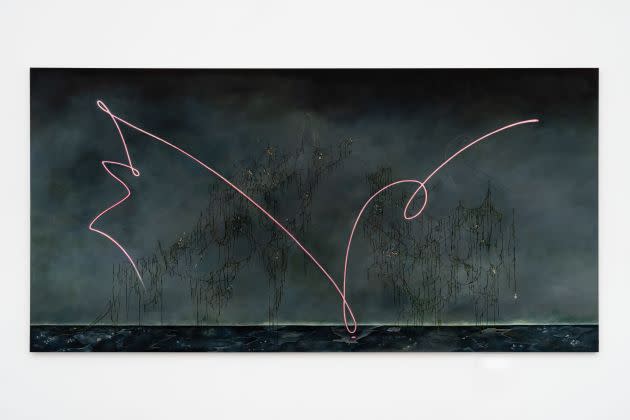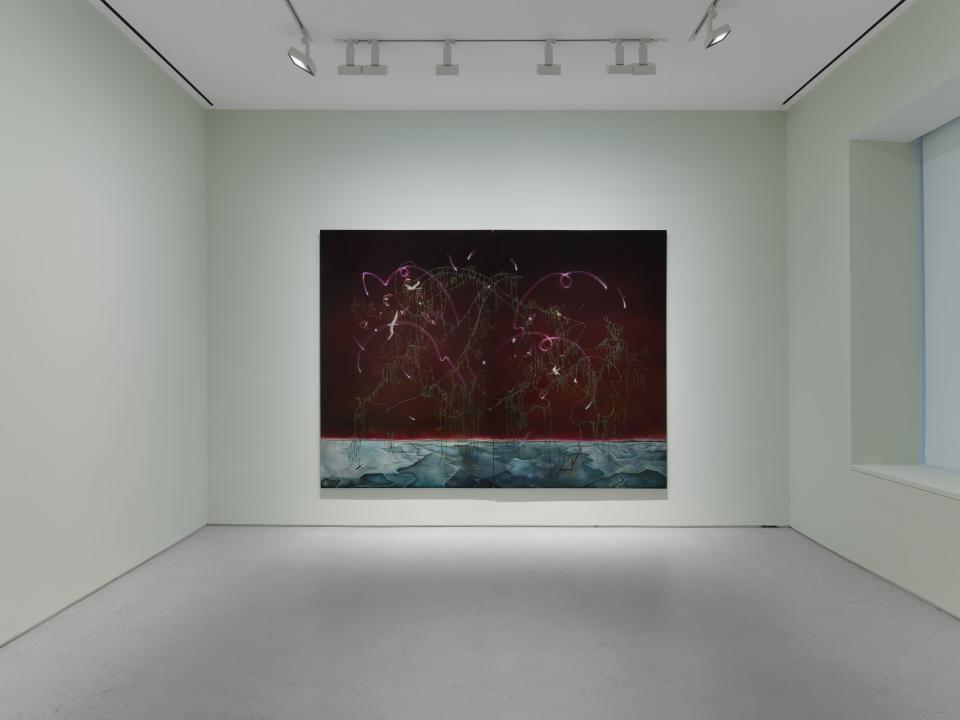Inside Anj Smith’s ‘Drifting Habitations’ Exhibition at Hauser & Wirth

“If I had to sum up what these paintings are, I’d say it’s about painting and about looking, and how we look,” says Anj Smith of her “Drifting Habitations,” her exhibition of new work on view at Hauser & Wirth in New York. “And why it’s important to look carefully. If we lose our capacity to really look carefully and think deeply, then we’re more at the mercy of post-truth and being able to be manipulated.”
Smith’s paintings invite viewers into the composition, using color as a primary seduction tool to encourage looking closer to uncover details and meaning. In her largest work, “If Winter Comes (Can Spring Be Far Behind?),” a diptych rooted in an inky aubergine backdrop, the faint outlines of figures emerge under an icy body of water — a fin, a flash of a tail, tentacles — their stillness juxtaposed with the movement of creatures within mossy strands suspended in the painting’s sky. The effect calls to mind a Rorschach test, one in which what the viewer sees in the work, and in what order, has the ability to guide their perception. Smith notes that collectors often email her about discovering new aspects within her paintings years after their acquisition.
More from WWD
Burberry Celebrates Highgrove Gardens With Limited-edition Scarves
New Exhibit Shows How Paul Poiret, Jeanne Lanvin and Cartier Helped Shape 'Modern Paris'
“On Instagram and on social media we’re used to looking at imagery really quickly and in quite a shallow way, and so I’ve deliberately positioned my practice counterintuitively against that,” says the British painter, in town for the exhibition’s opening. “So that these things unfold really slowly.”

Describing her paintings as conceptual, Smith notes that her approach is primarily invested in the viewer’s interpretation of the visual. Two philosophical questions guided the creation of her latest series: “What is there? And then, if there is anything, what is the nature of that thing? How do we perceive our realities?” she says.
The exhibition includes paintings of various scales — the intimacy with each created by the viewer’s willingness to engage — and depicts water, a new visual element in her work, in its various states.
“Water is very amorphous by its very nature, it doesn’t have set contours, and it’s very changeable,” she says. “So it has all of this potential for being many different things. That really fascinates me. But at the same time, it’s a singular element. It’s water. It’s always water,” she adds. “The sense of self that I’m trying to encapsulate in my painting is something that is one thing; it’s one human life, but at the same time it’s really impossible to pin down a concrete, coherent, singular identity in any of these figures. And that’s the whole point — that it’s impossible to do so. And yet we live in this moment where there’s such a drive towards trying to encapsulate and label, and especially force on women a particular way of existing in some fantasy perfect state.”
Many of the paintings depict a nude female figure, peering out from the canvas from behind glasses and mesh panels. The first work Smith created for the series, which hangs in the gallery’s entrance, is “Double Flowering (of the Marsh Marigold).” She mulls the idea of an oscillating sense of self, conveyed through “pairs” of objects within the work, as well as the challenge of representing the female body.
“Painting the female nude was a very big deal, because it’s so loaded. And I have not felt comfortable addressing and taking on such a problematic subject and genre in painting until now,” says Smith. “You’re dealing with the gaze, and then you’re dealing with the refutation of the gaze,” she adds. “But that in itself became quite problematic. And so I felt as though what I could offer this conversation was presenting the conundrum of the female nude. Not presenting any neat conclusion. What I think can be powerful about some of these poses is that they’re just existing. And sometimes that can be the most powerful act of resistance.”
That stillness is juxtaposed by the constant possibility of change, anxiety that seeps through in a sense of ecological change present in each of her painted scenes. Like water, and like the identity of her female figures, the state of the geographic world is in constant motion.
The show’s title, “Drifting Habitations,” references French semanticist Roland Barthes’ definition of atopia — that which is difficult to pin down.
“It’s just so impossible to encapsulate in language, whether it’s written or whether it’s painted, our experiences. We’re never going to be fully able to share an experience with anyone,” says Smith. “But as I’ve encountered more of life, I feel as though the attempt to communicate is very precious and valuable, and the only thing we have as humans,” she adds. “And the attempt to connect is something that should be treasured.”
Launch Gallery: Inside Anj Smith's 'Drifting Habitations' Exhibition at Hauser & Wirth
Best of WWD

